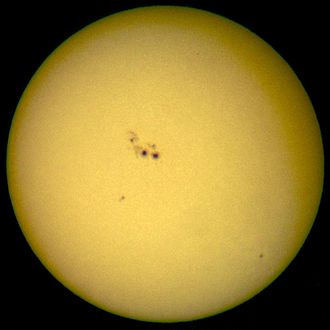Difference between revisions of "AY Honors/Stars/Sunspot/es"
From Pathfinder Wiki
(Created page with "Libro de Respuestas de Especialidades JA/Estrellas/Mancha Solar") |
(Created page with "</noinclude> thumb|El sol con manchas solares Una mancha solar es una región en la superficie del sol que se caracteriz...") |
||
| Line 1: | Line 1: | ||
<noinclude></noinclude> | <noinclude></noinclude> | ||
| − | [[image:Sun projection with spotting-scope large.jpg|thumb| | + | [[image:Sun projection with spotting-scope large.jpg|thumb|El sol con manchas solares]] |
| − | + | Una mancha solar es una región en la superficie del sol que se caracteriza por una temperatura más baja que sus alrededores y una intensa actividad magnética, formando áreas de baja temperatura de superficie. Aunque son muy brillantes, a temperaturas de aproximadamente 4000-4500° K, el contraste con el material circundante de algún 5700° K los hace claramente visibles como manchas oscuras. Si se aislaran de la fotosfera circundante, serían más brillantes que un arco eléctrico. | |
<br style="clear:both"/> | <br style="clear:both"/> | ||
<noinclude></noinclude> | <noinclude></noinclude> | ||
[[Category:Adventist Youth Honors Answer Book|{{SUBPAGENAME}}]] | [[Category:Adventist Youth Honors Answer Book|{{SUBPAGENAME}}]] | ||
Revision as of 13:45, 16 March 2015
Una mancha solar es una región en la superficie del sol que se caracteriza por una temperatura más baja que sus alrededores y una intensa actividad magnética, formando áreas de baja temperatura de superficie. Aunque son muy brillantes, a temperaturas de aproximadamente 4000-4500° K, el contraste con el material circundante de algún 5700° K los hace claramente visibles como manchas oscuras. Si se aislaran de la fotosfera circundante, serían más brillantes que un arco eléctrico.

